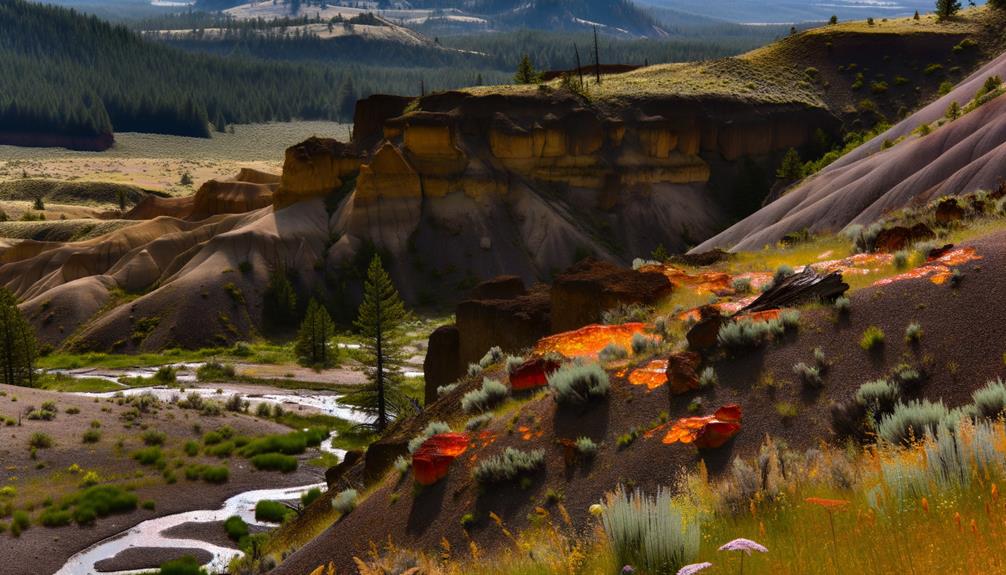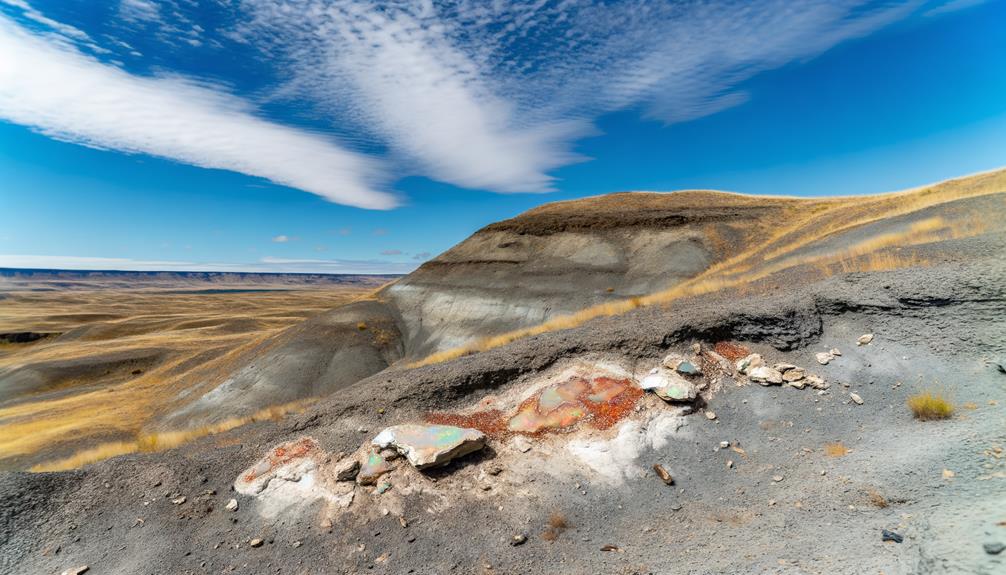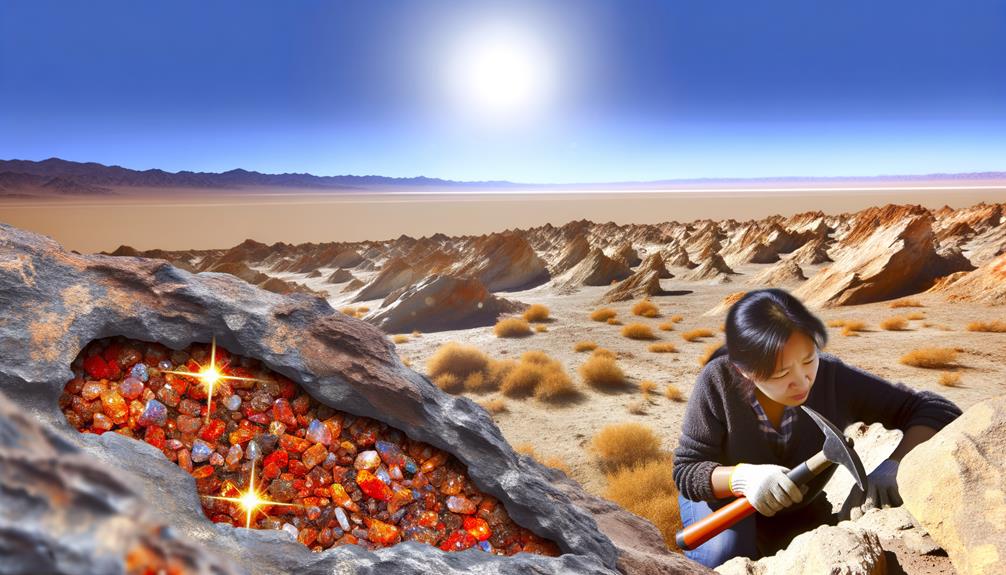7 Top Spots to Find Oregon Fire Opal
To find Oregon fire opal, start at Opal Butte in eastern Oregon, renowned for high-quality, rhyolite-hosted opals. Juniper Ridge Opal Mine employs open-pit and underground methods to uncover varied opal grades.
At Opal Queen Mine, focus on rhyolite fractures and cavities for vivid play-of-color specimens. Additionally, explore Glass Buttes, Hart Mountain, and Warner Valley for diverse geological formations and vibrant opals.
Equip yourself with rock hammers, chisels, and safety gear. Understanding the geological context, including rhyolitic peripheries and structural characteristics, is essential for successful prospecting.
For more nuanced tips, practical guidelines await exploration.

Key Takeaways
- Opal Butte in eastern Oregon offers high-quality fire opals in rhyolite-hosted veins.
- Juniper Ridge Opal Mine utilizes both open-pit and underground mining techniques for fire opal extraction.
- Opal Queen Mine is renowned for its vivid fire opals embedded in rhyolite matrix.
- Glass Buttes in central Oregon provides opportunities for fire opal prospecting in rhyolitic peripheries.
- Hart Mountain is a prime location for extracting high-quality fire opals from rhyolite host rock.
Opal Butte

Opal Butte, situated in eastern Oregon, offers a prime location for discovering high-quality fire opals due to its unique geological formations and rich mineral deposits. You'll notice that rhyolite-hosted opals dominate the area, formed through volcanic activity. The opals here often display vibrant hues, ranging from red to orange, indicative of their high silica content and trace elements.
When prospecting, focus on the vein structures; they're typically where the most significant opal deposits form. Tools like rock hammers and chisels are essential for extracting specimens from the tough rhyolite matrix. Remember, the accurate identification of opal-bearing rocks requires careful observation of color play and transparency. This analytical approach helps you maximize your chances of uncovering valuable fire opals.
Juniper Ridge Opal Mine
At Juniper Ridge Opal Mine, you'll encounter both open-pit and underground mining techniques, each influencing the extraction process.
Understanding the opal quality grades, from commercial to gem-quality, is essential for evaluating your finds.
This mine offers a unique opportunity to analyze opal's structural characteristics and color variations firsthand.
Mining Techniques Overview
Mining at Juniper Ridge Opal Mine employs a combination of open-pit and hand-dug methods to carefully extract the delicate fire opals embedded within the volcanic rock. Open-pit mining involves removing the surface layer of rock and soil, exposing the opal-bearing strata.
You'll then see miners using handheld tools like picks and chisels to meticulously extract the opals, minimizing damage to the fragile gemstones. The process requires precise excavation techniques to avoid fracturing the opals, which are often found in thin seams.
Additionally, water is frequently used to wash away loose material, providing clearer visibility of the opal deposits. This dual approach guarantees both efficiency and the preservation of the mineral's natural beauty.
Opal Quality Grades
Grading the fire opals from Juniper Ridge Opal Mine involves categorizing them based on color intensity, clarity, and the presence of unique patterns. You'll want to focus on these key attributes to determine the quality of each opal. High-quality opals showcase vivid hues, minimal inclusions, and distinctive play-of-color patterns. Lower grades may lack intensity, exhibit cloudiness, or have fewer visual features.
| Quality Grade | Description |
|---|---|
| AAA | Superior color intensity, high clarity, unique patterns |
| AA | Strong color, slight inclusions, moderate patterns |
| A | Moderate color, noticeable inclusions, limited patterns |
| B | Low color intensity, high inclusions, few patterns |
Understanding these grades helps you accurately assess the value and desirability of your fire opals.
Opal Queen Mine

The Opal Queen Mine, renowned for its high-quality Oregon fire opals, offers a valuable opportunity for gem enthusiasts to explore rich deposits.
You'll find opals embedded in rhyolite matrix, a volcanic rock where silica-rich solutions have solidified. This location's geochemical conditions have produced opals with vivid play-of-color, ranging from deep reds to bright oranges.
When prospecting, focus on fractures and cavities within the rhyolite, as these are prime opal-bearing zones. Bring tools like rock hammers and chisels to extract specimens safely.
Analyzing the fire opal's clarity and color intensity will help you evaluate its quality. Remember to wear protective gear; opal mining can be physically demanding and requires adherence to safety protocols.
Sunstone Knoll
Located in the arid terrain of southern Utah, Sunstone Knoll provides a unique location for discovering rare, transparent sunstones with a striking range of colors. You can find these gemstones, technically known as labradorite, embedded within the basaltic lava flows.
The sunstones display a spectrum from pale yellow to deep red, attributed to varying copper content. Use a rock hammer and chisel for extraction, targeting the vesicular basalt where sunstones are often trapped. Make sure you wear protective gear, including gloves and safety glasses, to avoid injuries.
Analyzing the crystal structure under polarized light can reveal valuable inclusions. This locale's geological conditions create an excellent environment for the formation of these beautiful gemstones.
Glass Buttes

You'll find Glass Buttes in central Oregon, renowned for its abundant obsidian deposits and diverse volcanic glass formations. The area consists of two primary peaks, North and South Glass Buttes, each presenting a variety of mineralogical treasures.
When prospecting for fire opal, focus on the rhyolitic peripheries where silica-rich deposits are prevalent. Employ a rock hammer and chisel to carefully extract specimens embedded within the matrix. Analyze your finds for characteristic opalescence and color play, indicative of high-quality fire opal.
Glass Buttes also offers a plethora of phenocrysts and vesicular textures, enhancing its geological significance. Always follow local guidelines and obtain necessary permits to assure responsible and legal collecting.
Hart Mountain
Shifting your focus from Glass Buttes, Hart Mountain in southeastern Oregon offers another prime location for those seeking high-quality fire opal specimens. At Hart Mountain, you'll find opals embedded in rhyolite host rock, indicating volcanic activity's critical role in their formation. Employ tools like rock hammers and chisels to extract these precious stones, often displaying vivid play-of-color.
Analyze the geological strata carefully; opals typically form in cavities and fractures within the rhyolite. Check for signs of silica-rich fluids that have percolated through the rock, facilitating opal creation.
When collecting, make sure you bring proper safety gear and hydration, as the terrain can be rugged. Hart Mountain's remote location demands thorough preparation, but the potential rewards make it worthwhile.
Warner Valley

In Warner Valley, you'll encounter unique geological formations that contribute to the presence of fire opals.
Focus on the popular digging sites such as the Warner Valley Opal Mine, where you can systematically search for these vibrant gemstones.
Understanding the region's volcanic activity and silica-rich deposits will enhance your chances of successful finds.
Geological Formation Insights
Warner Valley's geological formation, characterized by its unique volcanic activity and mineral-rich deposits, provides an ideal environment for the creation of Oregon fire opals.
You'll find that the valley's stratigraphy includes rhyolitic lava flows, which are vital for opal formation. When volcanic silica-rich ash interacts with water over millennia, it precipitates silica gel. This gel fills the voids in volcanic rocks, gradually solidifying into opal.
Additionally, the valley's geothermal activity enhances this process by constantly dissolving and redepositing silica, promoting the growth of opal deposits. The interplay of these geological factors results in the vibrant colors and brilliant play-of-color that distinguish Oregon fire opals.
Understanding this formation process is essential for identifying promising excavation sites.
Popular Digging Sites
Exploration of Warner Valley for Oregon fire opals should begin at the renowned Bonanza Opal Mine, known for its rich and accessible deposits. You'll find opal-bearing rhyolite here, where systematic digging often yields high-quality specimens. Bring a rock pick and sifting screens; the mine's management allows you to keep what you find, making it ideal for hobbyists and professionals alike.
Nearby, the Rainbow Ridge Opal Mine offers another productive site. You're encouraged to search tailing piles and unearth hidden gems. The geological formation here consists of volcanic ash layers, which can be easily excavated with basic tools.
Always wear protective gear and analyze the strata for opal veins, ensuring a systematic and effective approach to your digging activities.
McDermitt Region
Nestled in the southeastern corner of Oregon, the McDermitt Region is renowned for its abundant deposits of high-quality fire opals. You'll find that the geological formations here are rich in silica, which is crucial for opal creation. The opals exhibit vibrant colors due to the unique volcanic activity in the area.
| Geological Feature | Description |
|---|---|
| Rock Type | Rhyolite and basalt |
| Opal Color Range | Red, orange, yellow |
| Mining Method | Open-pit and underground mining |
| Accessibility | Moderate, with some areas necessitating 4×4 vehicles |
When you're prospecting in McDermitt, focus on rhyolitic tuff and basaltic rocks. These matrices often contain pockets of opal. Employ both surface surveys and subsurface explorations to maximize your findings. This region's high mineralization guarantees rewarding yields for diligent miners.
Conclusion
You've navigated numerous remarkable locations for Oregon fire opal. From Opal Butte's brilliant boulders to Juniper Ridge's radiant rocks, each site offers unique opportunities.
Opal Queen Mine's quality gems and Sunstone Knoll's sparkling stones stand out, while Glass Buttes and Hart Mountain provide promising prospects.
Warner Valley's varied finds and the McDermitt Region's rich resources round out your quest. Each expedition promises precise, professional pursuit of these prized, picturesque opals, ensuring a satisfying and successful search.






